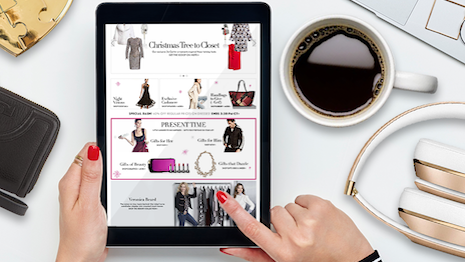Mobile acts as omnichannel’s connective tissue, says L2
December 19, 2016

There are few omnichannel leaders and many followers among the nearly 100 U.S. and U.K. retailers surveyed by L2 for its fourth annual “Intelligence Report: Omnichannel Retail 2016.”
The rise of digital has sparked opportunity for retailers by creating “always-on interactions,” but internal infrastructure and technologies as well as consumer behavior and devices have progressed slowly. Although retailers are improving omnichannel offerings, L2 found that only six retailers analyzed can be seen as strategy leaders.
"No matter what state of omnichannel integration brands are at, there is always an opportunity to take it to the next step,"said Mike Frogatt, director of intelligence at L2. "Featuring in-store availability on your product display pages? Take it to the next step by letting shoppers filter for in-store products in your navigation.
"Invest in a great mobile optimized store locator? Offer to send directions right to your shopper’s mobile device," he said. "Building omnichannel features for your customers is an incremental process—test and learn how they shop to stay ahead of behavioral trends for maximum value."
"Sales associates are the face of your store experience—and ultimately your brand—while technology is a tool that can be used by both HQ and in-store to enhance value. This is especially true in luxury, where the high-value consumer expects more of a relationship."
L2's Intelligence Report: Omnichannel Retail 2016 tracked 89 retailers in the U.S. and seven in the U.K., all of which have physical and online storefronts. Core digital indicators considered include in-site and store integration, shipping and fulfillment, mobile enablement and retail organization.
Connecting the dots
Year-over-year, L2 has found that 78 percent of retailers have improved their omnichannel offerings in-store and online.
Year-over-year, L2 has found that 78 percent of retailers have improved their omnichannel offerings in-store and online.
Sixty-seven percent of retailers improved digital incentives to drive in-store visits and 44 percent bettered their ecommerce efforts. Another 19 percent saw a decline in both areas.
"Find and implement the core technology that works for you and your brand: integrate digital inventory, customer relationship management (CRM) software, mobile devices in-store, etc., and then train your sales associates on how to use that technology to be an irreplaceable resource to customers," Mr. Froggatt said.
Site and store integration relies heavily on location, but not all retailers have mastered optimizing the consumer path from online to physical selling. Per L2’s report, a number of features related to location have neared “mass adoption.”
Fifty-eight percent of retailers auto-detect a consumer’s location based on IP address and 48 percent filter store locators by product category or service. Many retailers though are still grasping at functionality, with only 22 percent offering an option to send bricks-and-mortar location directions via SMS to a consumer’s mobile device.
Image courtesy of Neiman Marcus
Sectors performing best regarding shopper location include activewear and big box retailers with percentages in the high 80s. Apparel and Accessories follows at 69 percent and department stores, who are struggling the most in terms of revenue sales, only clock in at 38 percent.
Whereas activewear, big box and apparel and accessories have all increased functionality by more than 10 percent than the year-ago, department stores have not.
L2 stresses the importance of shipping and fulfillment marketing and consumer education. While omnichannel strategies are necessary, if consumers are unaware then the efforts are wasted.
The best way to educate consumers on omnichannel fulfilment is not social media or paid search, but rather email messaging. ROI research suggests that email has a median return of 122 percent, or more than four times that of social or search.
Image courtesy of Bloomingdale's
Despite this, L2 found that retailers are not properly using email to push omnichannel features.
While free shipping promotions are visible on-site and by email at a rate of 88 percent and 89 percent, respectively, in-store pickup availability is not as widely promoted. Although click-and-collect is very popular, only 47 percent who offer the service promote online and less than 10 percent inform consumers via email.
Mobile is also a vital ingredient for omnichannel. L2 notes that mobile should not be viewed as only a sales tool but rather the “connective tissue” between digital and in-store.
Based on its research, retailers have built our their mobile capabilities. Seventy-four percent of retailers surveyed for the Intelligence Report, for example, have a commerce-enabled mobile application.
These advancements are reflective of consumer behavior. Today, one in three online purchases is made from a smartphone, and nine out of 10 consumers have used their mobile device in-store. Also, eight in 10 purchased made have been influenced by mobile.
Mobile toolkits
Despite the overall boom in mobile transactions, a separate L2 report finds that its growth is not yet optimal due to inefficiencies in checkout and payment tracks.
Despite the overall boom in mobile transactions, a separate L2 report finds that its growth is not yet optimal due to inefficiencies in checkout and payment tracks.
The report sheds light on the state of mobile transactions by surveying a variety of metrics including transaction impetus, expedited payment options and conversion rates. The resulting data is rich in insight for brands that are looking to optimize their mobile-based sales in a high-impact yet organic fashion (see story).
Chatbots have emerged as an omnichannel touchpoint that, like mobile apps and Web, connect consumers to retailers via their device.
Department store chain Nordstrom, for example, has enlisting a conversational agent to help consumers pinpoint the perfect present for everyone on their list.
The retailer timed the release of its first chatbot for the holiday shopping season, programming a series of questions designed to build a profile of the recipient and relevant product recommendations for the gifter. With the pressure of shopping for others, which can lead some to draw a blank on what to get, this bot offers a natural path toward purchase.
While the chatbot is not a real person, it acts as an extension of Nordstrom's customer care team. This feature allows the retailer to provide a customized consultation to many consumers at once (see story).
"Luxury brands in general tend to be more in-store focused; this isn't a bad thing, but it is a strategic decision," L2's Mr. Froggatt said. "Montblanc and Richemont are investing rapidly in both ecommerce and digital in-store incentives, and they improved the most out of all luxury brands surveyed year-over-year.
"They are very focused on how to facilitate the digital 'hand-off' to an in-store associate and a guided selling environment," he said. "They manage both limited-run items as well as items that have higher inventory numbers and provide effective digital services to help customers locate those products.
"LVMH is another great portfolio of brands focused on the service aspect mentioned earlier and not necessarily rushing to close the deal online, as well as investing in ways to drive consumers to their stores."


No comments:
Post a Comment